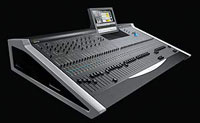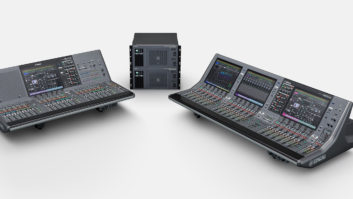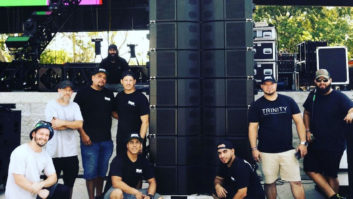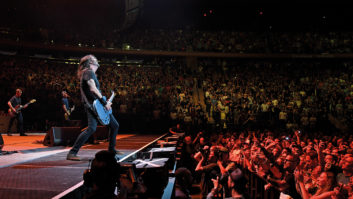
The Innovason Eclipse can handle up to 320 inputs.
A decade ago, this article would have been very short, but in that time, live digital consoles have come into their own. Today, they are not only being accepted by the live sound community, but also truly dominating major segments of the touring market. As the technology has matured, several trends have emerged. Greater numbers of channels are being controlled by increasingly smaller controllers; plug-ins are being accepted into the FOH and monitor “racks”; and as ever, software upgrades can expand the feature set of existing products without fear of obsolescence or bankrupting the sound company.
That said, there’s a whole lot of product research going on in digital consoles for live applications. We checked in with manufacturers (listed alphabetically), asking about developments over the past year.
Available in standard formats or customized to user requirements, Allen & Heath‘s (www.ilive-digital.com) iLive modular mix system combines a central iDR10 Mix-Rack loaded with the iDR-64 mix engine (offering 64 mix inputs and 32 configurable mix buses) and an iLive Surface controller. The flight-cased control surfaces are now available in four sizes, each with four layers: iLive-80 has 20 faders (x4 layers for 80 assignable strips); the iLive 112 has 28 faders for 112 strips; the 36-fader iLive-144 has 144 strips; and the 44-fader iLive-176 has 176 strips.
The iLive V. 1.3 software update features engineers’ fader strips for wedges and in-ears, for separate fader control, and dedicated outputs to the operator’s listen wedge and IEM personal system. Optional processing and aux monitor mixes can be assigned to wedge or IEM strips. A new onboard Real Time Analyzer (RTA) lets users quickly identify feedback, tune room acoustics, tailor wedges and view the frequency content of any input or mix — or the spectrum of the main mix. Other pluses in V. 1.3 include two new FX presets — Symphonic Chorus and Hypabass, a sub-harmonic synthesizer — and the ability to control iLive from A&H’s range of PL controllers for remote adjustment of mixes, mutes, levels and scene presets.
New iLive Editor software provides access to iLive’s key facilities, with the convenience of viewing multiple information panels simultaneously. The Java-based program lets users configure show settings, or make changes to existing shows online or offline to save for later uploads. Besides the convenience of designing console setups from the tour bus or hotel, TCP/IP connectivity allows live channel mixing and processing over via Cat-5 or WiFi for tweaking console settings from anywhere in a venue using your laptop.
Cadac (www.cadac-sound.com) has announced Q2 2009 shipping for its much-anticipated S-Digital live theater desk, which reflects the surface architecture of Cadac’s J-Type analog board, offering a familiar mix environment, but with the benefit of digital control. The board combines a low-latency proprietary High Speed Digital (HSD)™ communications system with a core busing system based around FPGAs with dedicated SHARC DSP devices within the DSP rack. This handles all input and output channels with fiber-optic or co-ax interfacing to the Stage Rack/preamps. A unique feature is scalability. Additional control surface frames can be brought in during rehearsals (for single- or multi-operator use) and then removed/relocated to reduce the mix footprint during performances.
After extensive testing on major tours, CIA Digital Console Systems (www.ciallc.com) announces the System 32 — a 32-input/output, software-driven virtual console powered by RML Labs’ (www.softwareaudioconsole.com) SAC application. This FOH mixing solution can be internally split to 24 separate monitor consoles, utilizing a legacy console strip GUI that approximates the look of an analog board. Each of the 24 monitor consoles in this 6U rolling rack (now with a shock-mounted ATA case option) can be remotely controlled via a TCP/IP connection. Standard features include parametric EQ, compressor and gating on every channel, 16 DCAs, six stereo aux sends, eight master outs (and 16 virtual outputs) and 7.1 mixing capability. In addition to the 32-channel model, 48/64/72-channel versions are also offered.
The SD8 from DiGiCo (www.digiconsoles.com) provides the major features and remote preamps of its D Series in a small-footprint package. Stealth digital processing in its Tiger SHARC FX engine offers effects, reverbs, dynamics, output matrix and more. Features include 37 moving faders, multifunction control knobs, electronic labeling and a 15-inch touch-sensitive hi-res TFT display. All 24 channel faders and 12 assignable aux/master faders can be instantly assigned as channels or masters, allowing 36 main faders to control inputs, if desired.
Even with the SD8’s compact footprint, there’s plenty of horsepower. Sixty mono or stereo channels — the equivalent of 120 channels — can run full DSP simultaneously. Also standard are 20-step LED bar graph meters next to each channel fader and the same snapshot automation control (with removable USB storage of sessions and setups) as the other D Series consoles. Besides a full-function 48×8 Stage Rack with remote control of its studio-grade preamps and 100m MADI digital snake, the SD8 has onboard local I/O with eight mic/line inputs, eight line outputs and eight AES/EBU inputs/outputs.
Digidesign (www.digidesign.com) expands its VENUE digital consoles line with the D-Show Profile Mix Rack System, an all-inclusive system that provides a size-conscious alternative to the larger and expandable D-Show control surface. Shipping since last April, the $39,995 package provides a compact 24-fader VENUE control surface, D-Show V. 2.7 software,VENUEPack plug-in bundle and the Mix Rack with DSP and remote and local I/O. Mix Rack has two Mix Engine cards (expandable for more TDM plug-in processing), 48 analog XLR mic/line inputs, 16 XLR analog line outs (expandable to 32), eight analog TRS line-level I/O (assignable as discrete I/Os or insert pairs). 2-track analog/digital (AES or S/PDIF) I/O, MIDI I/O and an analog aux/com input. The system supports up to 64 tracks of Pro Tools record/play integration, and modular card slots allow various analog or digital outputs and Aviom A-Net personal monitoring options.
Profile Mix Rack ships with the VENUEPack 3.1 plug-in collection, which includes: Focusrite’s d2 and d3; Digidesign’s Impact, Reverb One, Smack! and ReVibe; and Bomb Factory’s BF-3A, Slightly Rude Compressor and Classic Compressors/MoogerFooger/Pultec Bundles. Among the upgrades in D-Show V. 2.7 software are cue workflows for monitor mixers, system lockout to prevent tampering in consoles located in public areas, real-time viewing of VCA automation tweaks and a comprehensive database for automatically updating plug-ins.
EAW (www.eaw.com) is finally shipping its UMX.96 24-bit, 96kHz digital live console, which features expandable 56×44 analog I/O, 3×12 integrated loudspeaker processing and full integration of SmaartLive, giving users immediate access to system measurement and calibration.
Software/firmware, V. 1.1, is now available, which brings many enhancements, such as effects and preset libraries, more snapshot capabilities with filtering and preview modes, improved file management, channel- and fader-safe modes, meter peak hold and screen-follows-selected channel options. Users will also appreciate the new UMX.96 Control Setup software. This gives users the offline ability to prepare shows in advance and transfer all necessary files to the console once they arrive at the venue.
Offered in versions for film/video post, broadcast and live, Harrison‘s (www.harrisonconsoles.com) Trion features a traditional surface rather than a central, shared-knobs approach. Hardware enhancements include transformer balanced mic preamps with a High-Z input setting for line-level and wireless mic inputs, and a Combo IO Unit intended for smaller configurations with 24 A/D converters, 16 ADCs and 16 AES I/Os, with MADI (optical or copper) interfacing to/from the board’s MADI router, which now has 12 4×1 summing points.
This lets the user select various mic inputs, sum them within the router and send them to recorders, trucks, etc., thus freeing more console inputs for mixing. Additonally, the MADI router can be set up with up to eight partitions, allowing router crosspoints to be stored/recalled independently, which is ideal for routing stage monitor or truck feeds without affecting console recalls. Harrison also offers new plug-ins for live users, including 2- and 6-Band DeNoisers, DeEsser, Sub-Harmonic Generator and Analog Tape Saturation, while adding FFT displays to its Harmonic Notch Filters and Buzz/Hum Killer. Other effects planned in the coming months include chorus, flange Stadium Simulation and more.
Keeping with the trend of smaller, high-power systems, Innovason (www.innovason.com) will soon be shipping its Eclipse digital control surface, the company’s first new console release since it unveiled its flagship Sy80 in 2004. The Eclipse DSP engine lets users mix up to 104 inputs simultaneously into 48 mix buses with the capacity to manage up to 320 inputs on the console, using up to five remote audio racks. Eclipse is also the first live digital console with onboard multitrack recording, thanks to the MARS (Multitrack Audio Recording System) option, where 64-track audio can be recorded directly onto a hard disk plugged into the back of the console.
The compact (45.75×30.4-inch) surface has 48 faders and 48 configurable rotary knobs spread over four layers. The concept — called SmartPanel — effectively provides 96 “faders,” taking Innovason’s original SmartFAD concept to the next level and making the console equally at home at FOH, monitors or in a remote van. An ID LED on each channel strip provides at-a-glance indication of the bus or function assignment to any channel.
Eclipse is compatible with all existing I/O and effects modules and comes with a dual redundant power supply as standard, along with the new NOVA operating software, featuring a modern, user-friendly graphic interface. The Muxipaire interface connects via co-ax or fiber-optic cable to the 64 I/O Stage Box up to 500-meters away, and a Cat-5 port ties into a 64-channel bi-directional EtherSound network. MADI and Aviom connect modules are optional.
The big news at Lawo (www.lawo.de) is the smaller-surface mc256, which uses the same Lawo HD core as the other mc2 models, with up to 512 DSP channels, 144 summing buses and 8,192-crosspoint routing capacity. Key to the mc256 is its new control surface, which provides direct access to essential operating elements. Rarely used functions are handled via the touchscreen interface, for fast operation and a short learning curve. In addition, the new design reduces fader width to 30mm for efficient, ergonomic production. Every 16-fader bay has full-function, high-res TFT metering.
As in other mc2 models, the mc256 combines modularity with options for a second fader row and PPM insertions. With frame size choices from 32 to 80 faders and special flight-case versions, the console is adaptable to a wide range of applications.
In other news, Lawo announces Release version 4 software for its mc2 consoles. Besides adding features such as direct-out mute by fader, mix-minus self monitoring and tweaked graphical interface with more mouse functions, V. 4 adds Surround Fader Hyperpanning with a rotary knob twist for moving surround elements to any desired position with detailed metering in the AES-defined colors and the ability to offset any parameter.
CueStation 4.6 programming and control software for LCS Audio‘s (www.lcsaudio.com) flagship Matrix3 digital audio system, adds new features, including Macintosh OS 10.5 Leopard support, multiple cue lists, a light-on-dark color scheme and a redesigned SpaceMap window, in addition to many other updates and improvements to audio processing, automation and the user interface. Also new is the Meyer Sound-certified version of JazzMutant’s Lemur tablet, providing state-of-the-art programmable touchscreen control of the Matrix3.
Mackie‘s (www.mackie.com) TT System32 combines its TT24 digital live mixer, DS3232 digital snake, Cat-5 cable and U100 Network Card into a complete, 32×32 I/O plug-and-play mix system — just add stacks and racks. Recent system updates include the $1,199 LP48 Dolby Lake speaker processing card, adding two/three/four-way crossovers with delay, with all outputs assignable to the back panel of the TT24 or DS3232 and Dolby’s Ideal Graphic EQ™ and Lake Mesa™ parametric EQ. The user-configurable card has a full library of Mackie and EAW presets for easy system integration, and functions are controllable from the TT24.
The new TTv1.7 operating software enabling full I/O routing for digitally patching any channel or mix to any output. This enables the U100 and DS3232 to act as a digital splitter in FOH/monitor applications, assigning inputs/outputs to both consoles over Mackie’s low-latency, high-bandwidth U-Net audio/control protocol.
Adapting technologies from its larger sibling XL8, the new PRO6 from Midas (www.midasconsoles.com) offers similar audio performance in a smaller-footprint package. The PRO6 system comprises a Control Centre and two seven-rackspace units handling DSP and I/O. Despite its small 54×36-inch size, PRO6 can deliver up to 80 simultaneous input channels and as many as 32 discrete mixes in monitor mode, with all channels having full EQ and numerous dynamics processing options.
The standard PRO6 has 56 channel inputs, eight returns and 41 buses (16 auxes, 16 matrix, three masters and six solos). Also included are eight internal stereo FX processors, parametric EQ, eight (up to 36 max) 31-band graphic EQs, 5.1 panning and 1,000-scene save/recall snapshot automation and show file archiving. Also standard is a dual-redundant (192×192) 100-meter digital snake using Cat-5e copper cabling. With more I/O hardware, the PRO6 network can expand up to 264 inputs and 264 outputs, and the Klark Teknik DN9696 Recorder can be used for live multitrack recording and virtual sound checks.
The PreSonus (www.presonus.com) StudioLive 16×4×2 digital live performance and recording digital mixer features FireWire recording with JetPLL synchronization, delivering 22 channels of recording and 18 channels of simultaneous playback. The heart of StudioLive is the Fat Channel, which features EQ and dynamics on every input channel, as well as on every aux, subgroup and main output. The highpass filter and four-band semiparametric algorithms are based on PreSonus’ digital EyeQ equalizer. Other features include LED metering, 100mm faders, talkback, Mac/PC multitrack recording software and the ability to export to WAV file formats for compatibility with any other DAW. The unit has 16 XMAX mic preamps and two programmable 24-bit stereo DSP engines offering reverbs, delays and time-based effects.
Roland Systems Group’s (www.rolandsystemsgroup.com) RSS V-Mixing System — which incorporates the RSS M-400 live digital console, configurable digital snakes, remote-control mic preamps/stage boxes and multitrack recording — has been enhanced with new V. 1.5 software. In response to user suggestions, the free upgrade adds numerous features, including more flexibility in compressor and gate assignments, direct output assignment capabilities for interfacing with personal mix systems and recording splits, tap tempo delay settings, the addition of eight matrices, and a variety of user-interface shortcuts for accelerated workflow and improved ease of use.
Another small-footprint/high-performance board is Soundcraft‘s (www.soundcraftdigital.com) new Si3, with 64 mono inputs, four stereo ins and 35 output buses (24 aux/group, eight matrixes and L/C/R main mix outs) in a single chassis. Standard are four onboard Lexicon effects processors, 12 VCA groups, eight mute groups and bar graph metering for all 35 bus outs. A touchscreen handles console setups; a Virtual Channel Strip with rotary encoders and OLEDs offers analog-style control and FaderGlow illumination along the fader track to indicate the currently active function. A redundant power-supply module, MADI interfaces and AES/EBU input cards are optional.
Soundcraft also announces V. 3 software for its Vi series, along with 96- and 72-channel upgrades for an input-to-mix capacity of 64 or 48 channels, mapped out on 32 or 24 motorized faders for the Vi6 and Vi4 respectively. The Vi6’s 96 channels to mix can comprise the 64 stage box mic/line inputs, 16 line inputs on the local rack and the eight stereo Lexicon effects returns. Alternatively, a second stage box can bring mic/line inputs to all 96 input channels.
The V. 3 upgrade also gives Vi4 access to all 35 output buses — without adding a DSP card. Further V. 3 enhancements include automation snapshot filtering; a revised Cue List Management suite with channel label import/export; improved master bay metering; and finer input/output delay trims — all available from the desk or using the Virtual Vi offline editor software for advance show setup/downloads via a USB stick.
Consoles just keep getting smaller, with the prize going to StageTec‘s (www.stagetec.com) AURATUS XCMC, which reduces the entire control and audio processing functionality of its compact AURATUS mixer onto a single board that slots into a standard NEXUS 3-U Base device. This new mixer-on-a-card supports console configurations of up to 54 audio channels and eight sums, eight aux buses, eight monitoring buses and eight mix-minus sums.
New for the company’s AURUS console is the AURUS Virtual Surface, a software application that’s ideal for use with a touchscreen tablet PC. Networked to AURUS via WLAN, this roving remote control lets users tweak/store console settings during rehearsals.
With a string of major tours and installs after only one year, Studer‘s (www.studer.ch) Vista 5 SR console keeps getting better. New is V. 4 software, which includes comprehensive 5.1 input source management and channel panning, but also an alternative Vintage Dynamics package. This offers a more retro style of compressor-gate/expander for a more pronounced, colored effect than the transparency of the standard dynamics, along with wet/dry blending and parallel compression presets. A new dedicated VST host plug-in engine lets users run favorite VST effects either as inserts or on effects sends, with recall on Vista’s Cuelist function.
Also standard in V. 4 are functions to speed up live operations, such as View Follows Solo/PFL, offering a choice of full-channel view or EQ/Dynamics/Pan view for faster parameter access during sound checks. And the new ability to copy aux mixes to other aux buses is intended to help monitor engineers dial mixes in quickly.
Just a year old, Yamaha‘s (www.yamahaca.com) DSP5D puts the functionality of its PM5D-RH digital console — less the control surface — into a rack unit that’s controllable from a PM5D. A single DSP5D doubles the mixer’s I/O channels, with 96 mono and 16 stereo channels accessible via four fader layers — or the user can add a second DSP5D unit for 144 mono/24 stereo capability. The DSP5D can reside next to the host PM5D or act as a remote stage box (with all I/O accessible on the front panel) with the use of an optional digital cabling unit for communication up to 120 meters away over standard Cat-5 cable.
Designed as the “perfect companion” to its M7CL and LS9 digital consoles, Yamaha’s SB168-ES Stage Box is also useable by the PM5D/DM1000/DM2000 consoles and DME digital mixing engine. Unveiled at AES and now shipping, the cost-effective SB168-ES is a scalable solution offering 16 channels of remote-controlled analog mic/line inputs, each with its own high-quality head amp, combined with eight line outputs, all at 48 kHz. Up to four digital Stage Box units can be connected offering a total of 64 inputs and 32 outputs, depending on the number of YGDAI card slots available on the specific console. The inputs/outputs can also be assigned to any of the 64 channels on an AuviTran ES-100 unit for EtherSound connectivity.
George Petersen is the executive editor of Mix and runs a small record label atwww.jenpet.com.







